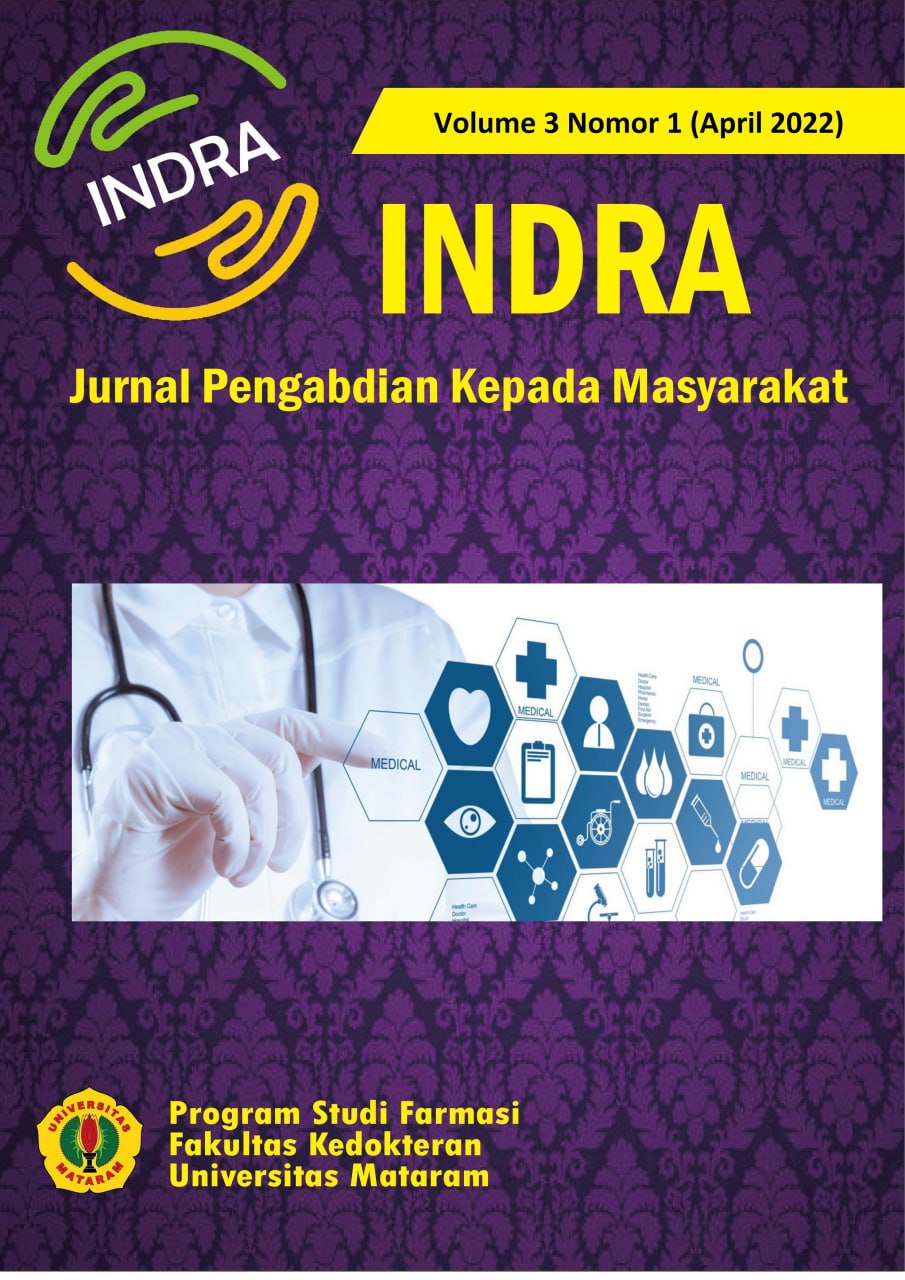Edukasi herbal dan pengolahan minuman herbal sebagai peningkat sistem imun untuk mencegah infeksi COVID-19
DOI:
10.29303/indra.v3i1.144Published:
2022-04-30Downloads
Abstract
The COVID-19 situation at the global and national levels is still at very high risk. A good immune system is needed to protect us from COVID-19. Eating healthy meals and increasing antioxidant consumption can help us to boost the body's immune system. Some herbs in Indonesia that are useful in boosting the immune system based on the Traditional Medicine Formulary are included red ginger, lime, cinnamon, and garlic. The Red ginger rhizome contains gingerol and shogaol, cinnamon bark contains cinnamaldehyde, lime has a high vitamin C content, and garlic bulbs contain ajoene. All of these compounds can synergistically improve the immune system. These ingredients are widely available and are processed into antioxidant herbal drinks that increase the immune system. The activity was carried out using the lecture method, discussion, and pretest-posttest to measure the level of participant knowledge. After the implementation of the activity, public knowledge increased regarding herbal ingredients, their processing, and preparation. As many as 100 percent of respondents were recognized the types of immune system enhancing herbs, 72 percent were understood how to process herbs, and 92 percent were understood how to prepare these herbs.
Keywords:
Red ginger, Cinnamon, Lime, Garlic, ImmuneReferences
Boshtam, M., Moshtaghian, J., Naderi, G., Asgary, S., & Nayeri, H. (2011). Antioxidant effects of Citrus aurantifolia (Christm) juice and peel extract on LDL oxidation. J Res Med Sci, 16(7), 951–955.
Eid, K. M., & Iraqi, M. M., (2014), Effect of garlic powder on growth performance and immune response for newcastle and avian influenza virus diseases in broiler of chickens. Prociding of 2nd International Conference On Biotechnology Applications In Agriculture (ICBAA), Benha University, Moshtohor and Hurghada, 8-12, April 2014, Egypt.
Kementerian Kesehatan, (2020), Pedoman Pencegahan dan Pengendalian Corona virus diseases 2019 (COVID-19), Keputusan Menteri Kesehatan Republik Indonesia Nomor HK.01.07/MENKES/413/2020.
Lete, Inaki & Jose, Allue, (2016), The Effectiveness of Ginger in the Prevention of Nausea and Vomiting during pregnancy and chemotherapy. Integr Med Insight, 11, 11-17. doi: 10.4137/IMI.S36273
Mellawati, Dyah, Sudarsono dan Ag. Yuswanto. 2010. Pengaruh Pemberian Ekstrak Zat Pedas Rimpang Jahe Emprit Yang Disari dengan Etanol 70% Terhadap Fagositosis Makrofag Pada Mencit Jantan Yang Diinfeksi Dengan Listeria Monocytogenes. Majalah Obat Tradisional, 15(3), 112 – 120.
Okwu, D. E. (2008). Citrus fruits: A Rich Source of Phytochemicals and their Role in Human Health. Int. J. Chem. Sci, 6(2), 451-471.
Papu, S., Jalvlr, S., Sweta, S., dan Singh, B.R. 2014, Medicinal values of garlic (Allium sativum L.) in human life: An overview. Greener Journal of Agricultural Sciences, 4 (6), 265-280. DOI:10.15580/GJAS.2014.6.031914151
Ramchandra, N.S. (2006). Immunomodulatory Activity Of Cinnamon Bark. Rajiv Gandhi University Of Health Sciences. Karnataka, Bangalore.
Singh V.K., & Singh D.K, (2008), Pharmacological Effects of Garlic (Allium sativum L.). ARBS Annual Review of Biomedical Sciences, 10, 6-26. DOI:10.5016/1806-8774.2008.v10p6
Wijayanti, W. A., Y. Zetra dan P. Burhan. (2011). Minyak Atsiri Dari Batang Cinnamomum burmanii (Kayu Manis) Dari Famili Lauraceae Sebagai Insektisida Alami, Antibakteri Dan Antioksidan. Skripsi. Fakultas Matematika dan Ilmu Pengetahuan Alam. Institut Teknologi Sepuluh Nopember.
License
Copyright (c) 2022 The Author(s)

This work is licensed under a Creative Commons Attribution 4.0 International License.











